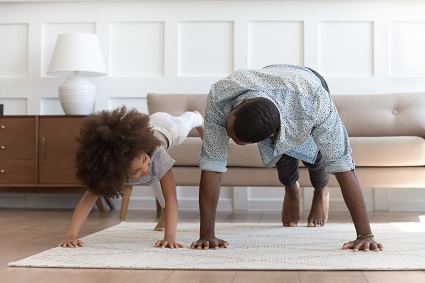
Summer 2020
Reducing Sedentary Time during the COVID-19 Pandemic
Dori Rosenberg, PhD, MPH✉ and Linda Trinh, PhD✉; Physical Activity SIG Chairs

Keeping physically active during the coronavirus pandemic can help improve your mental and physical health. However, even if you are physically active, spending too much time sitting or lying down (except for sleeping) is associated with worse health outcomes including greater risk for all cause mortality, cardiovascular disease, and type 2 diabetes. It is likely that sedentary time has increased population wide given that people are largely confined to their homes. Sedentary time has received significant attention in recent years due to the health risks associated with this behavior, as well as the high volumes of sitting time we engage in. Among the U.S. population, the estimated amount of sitting time has increased over time where adults now spend approximately 6.4 hours per day in total sitting time based on data obtained from the National Health and Nutrition Examination Survey (NHANES). In the updated Physical Activity Guidelines for Americans, it now suggests that most people would benefit from both increasing moderate-to-vigorous physical activity and reducing sitting time. There is insufficient evidence to recommend a specific healthy target goal of how much sitting time should be reduced or the number of interruptions throughout the day. While sitting time is unavoidable in our current society and especially during the pandemic, there are a number of ways we can interrupt the large volumes of sitting time that we accumulate throughout the day.
Interventions to reduce sedentary time are effective and may improve cardiometabolic health. From theories of habit formation, we surmise that sitting is an automatic, unconscious behavior that is habitual. To break the habit, bringing conscious awareness to sitting behavior is warranted. Over time new habits can then be established and can become more automatic. It is still not clear what specific behavior change strategies assist individuals in reducing their sedentary time. There is some evidence suggesting that self-monitoring is a viable strategy. However, it is cumbersome for people to record their sedentary time and, while there are a plethora of commercially available devices that provide tracking and feedback on physical activity, there are very few devices that provide information on how much sedentary time one is engaging in. The most valid field-based device for assessing sitting time is the activPAL accelerometer. This is a thigh worn device, which provides very accurate information but does not provide real time output. Therefore, it is primarily used within research studies as an outcome measure. Technologic advancements in the area of real time assessment of sedentary behavior are needed to advance the field.
There are many things you can do within your home environment, or at work once we are able to return, to alter your sedentary patterns. There are two main ways to do this: break up sitting bouts regularly and/or stand or move for periods of time throughout the day. Here are some suggestions from the Physical Activity SIG advisory board members that may help you to change your sedentary time.
|
Domain |
Strategy |
Tips |
|
Home environment |
Set up a standing desk |
You can look online for simple standing desk options ranging in price or try making your own or even use an ironing board |
|
|
Use your stairs |
Try taking extra laps up and down your home or apartment building |
|
|
Set up your home for movement |
Some examples include leave exercise shoes visible, move wastebaskets and printers away from your computer, use the bathroom on a different level in your home/office, set up your office space on a different level than the kids space so you move throughout the day |
|
|
Active meetings |
Take a walk, stand up or stretch during phone meetings or videoconferencing calls |
|
|
Meal preparation |
Instead of the kids watching TV while you prepare meals, turn on some music and have a family dance party around meal preparation |
|
|
Drink more water |
Drink more water so that you have to get up more often for a bathroom break |
|
Leaving your home (when leaving your home, follow physical distancing rules for your region/country) |
Curbside pickup and carryout |
Walk instead of drive to curbside pickups and carryout near your home |
|
|
Family walks |
Take family walks after dinner or at least once a day whenever your schedule permits |
|
External cues |
Set up inactivity/idle alerts on your fitness tracker |
Many fitness trackers have inactivity alert features that you can turn on |
|
|
Set reminders on your phone to get up and move |
You can set up reminders on your phone or download simple phone apps that provide alerts for you (e.g. Rise and Recharge, Stand Up!) |
|
|
Set reminders on your computer to get up and move or stretch |
Some program to try include Workrave, Big Stretch Reminder, Time Out (Mac) |
|
Habit reminders |
Add bouts of standing or moving to habits you already do |
Examples include: take a walk break every time you take a coffee break, stand up when on the telephone, stand up during commercial breaks, stand while reading the front section of the news, stand while drinking your coffee, take an extra lap around your home after going to the bathroom |
Look for opportunities to stand up and move more whenever you can, and as much as your abilities allow you to!